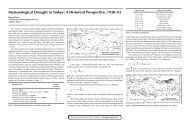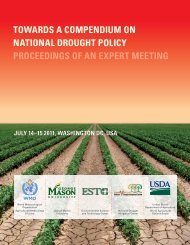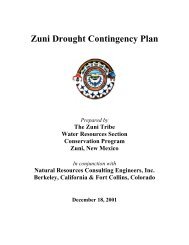Did you know . . . - the National Drought Mitigation Center
Did you know . . . - the National Drought Mitigation Center
Did you know . . . - the National Drought Mitigation Center
You also want an ePaper? Increase the reach of your titles
YUMPU automatically turns print PDFs into web optimized ePapers that Google loves.
Characteristics of <strong>Drought</strong> in Kerala, IndiaKerala state in India, which is <strong>the</strong> first area of <strong>the</strong>country to experience <strong>the</strong> southwest monsoon, has amoist and wet climate. Kerala is in <strong>the</strong> extremesouthwestern part of <strong>the</strong> Indian subcontinent; it bordersKarnataka state in <strong>the</strong> north, Tamil Nadu in <strong>the</strong>east, and <strong>the</strong> Arabian Sea in <strong>the</strong> west (Figure 1). Theentire state is one of <strong>the</strong> 35 meteorological subdivisionsin India.Kerala’s climate is tropical monsoon and tropicalsavanna, according to Koppen’s climatic classification(Figure 1). The state normally experiences excessiveseasonal rainfall, with hot summers (except in <strong>the</strong>extreme sou<strong>the</strong>rn districts like Trivandrum, wheredry season and hot summer climate prevails). Thethree main seasons of <strong>the</strong> state are <strong>the</strong> hot seasonK A R NCannanoreLakshadweep SeaTropical monsoon:Seasonally excessiverainfall, hot summerTropical savannah:Seasonally dry,hot summerAKozhikodeT AAlleppeyKKERALA100 80 60 40 20 0 100MalappuramTrichurAPalghatErnakulamKottayamQuilonTrivandrumIdukkiIndian OceanFigure 1. Climatic classification of Kerala.T A MI LN A DU(March–May), southwest monsoon season (May–September), and nor<strong>the</strong>ast monsoon season (October–February).The annual rainfall of <strong>the</strong> state varies from 3,800mm over <strong>the</strong> north to 1,800 mm in <strong>the</strong> extreme south.The potential rainy season for Kerala is <strong>the</strong> southwestmonsoon period, which contributes more than 80%of <strong>the</strong> annual rainfall. The monsoon rain decreasesfrom <strong>the</strong> north to <strong>the</strong> south. In recent years, a trend ofdecreasing rainfall has been seen both in seasonalrainfall and 10-day extreme rainfall duration.There is significant rainfall variation in north andsouth Kerala. North and south Kerala have tworainfall distribution subzones. In north Kerala, nor<strong>the</strong>astmonsoon rainfall shows a decreasing trend andcontributes about 15% of <strong>the</strong> annual rainfall. Thismay adversely affect cultivation of <strong>the</strong> second ricecrop in <strong>the</strong> area. Southwest monsoon rain, whichcontributes 82% of <strong>the</strong> area’s total rainfall, does notshow any increasing trend. Similarly, in south Kerala,southwest and nor<strong>the</strong>ast monsoon rains have decreasedby 5% and 8.3%, respectively. Mean annualrainfall is also decreasing in south Kerala.The decreasing rainfall over <strong>the</strong> region, late onsetof <strong>the</strong> monsoon, failure of <strong>the</strong> monsoon, and break in<strong>the</strong> monsoon in <strong>the</strong> state lead to many drought situations.Kerala had severe dry spells and droughts in1983, 1985, 1986, and 1987, even though <strong>the</strong> statehas a wet climate. There were dry spells of 5 and 4weeks in 1985 and 1986, respectively, during <strong>the</strong>southwest monsoon period.Damage due to drought was particularly significantin Kerala in 1987. About 1,500 villages in 14districts were affected, and 9.82 lakh 1 hectares ofcropland and 6 lakh cattle were also affected. DuringJanuary–May 1987, <strong>the</strong> entire Kerala region wasaffected by drought. About 30% of <strong>the</strong> rabi season11 lakh = 100,000<strong>Drought</strong> Network News3








